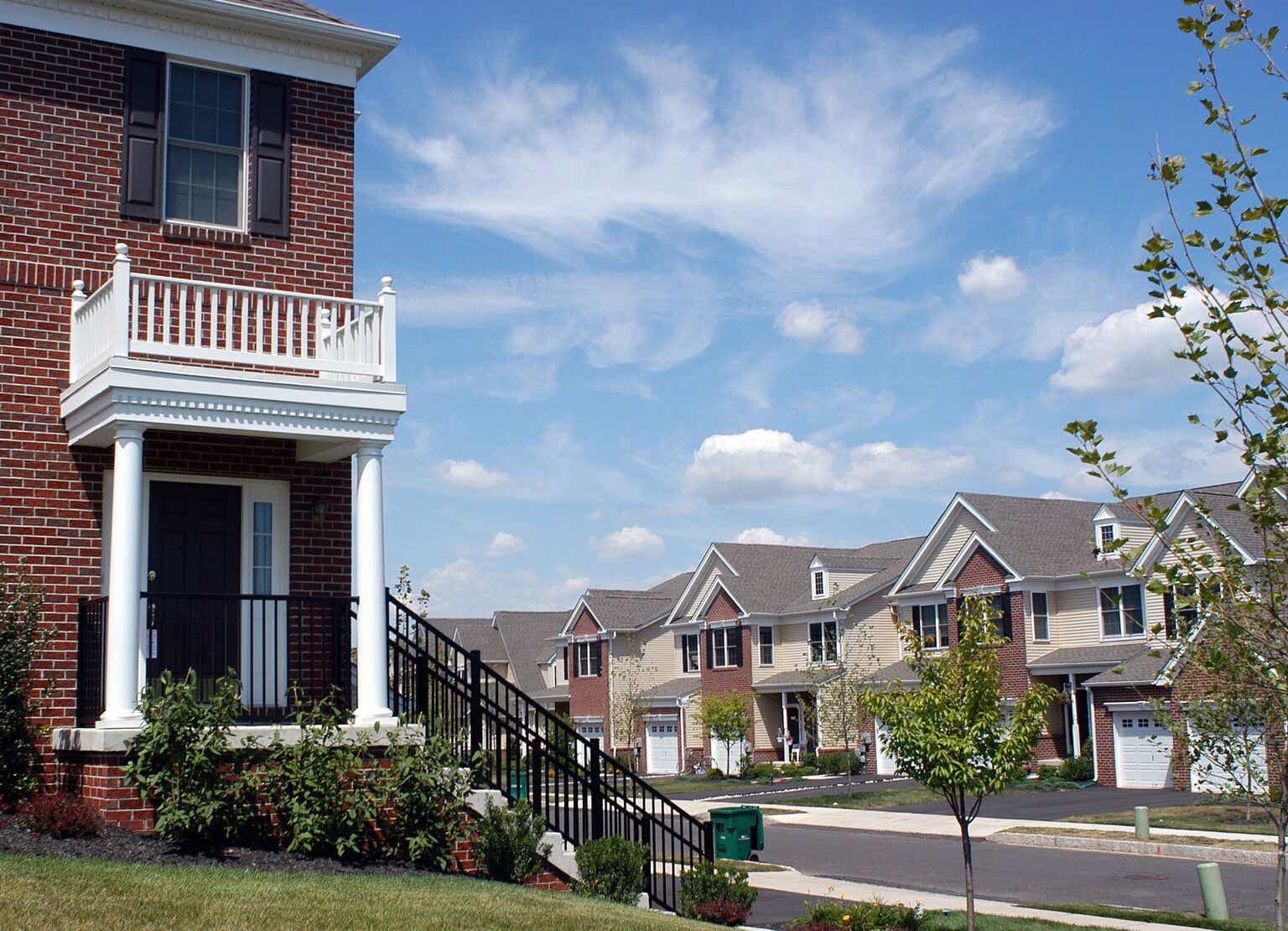Investment Thesis
Toll Brothers (NYSE:TOL) strong performance this year was still under the buoyancy provided by the previous backlog while multiple factors from the perspective of its own logistics and the macro picture suggested the slowdown ahead is still looming large. With its price rising above the bullish estimates we previously assessed, we recommend a sell for now.
Review
We previously initiated coverage of Toll Brothers in January this year with a hold rating when it was $55.46, expecting its price to be within a range of $45 to $62. The thesis was built on the expected slowdown from its backlog and the macro environment pressure, in addition to the normalization of the housing market. The company reported strong numbers so far this year, but our previous thesis still holds, and we will explain why.
Updates
Since our article was published in January this year, Toll Brothers’ annual growth rates for revenue, free cash flow, and gross profits have been trending flat to lower. Although they are coming back down from historic highs, the growth is nonetheless moderating.
Toll Brothers: Growth Rates (Calculated and Charted by Waterside Insight with data from company)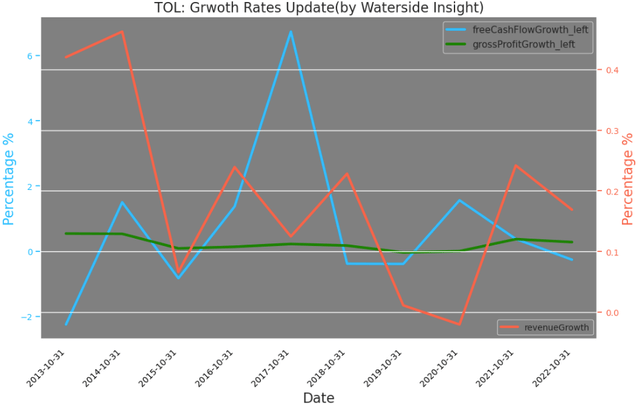
Toll Brothers’ backlog consists of homes under contract but not yet delivered to the home buyers. Just as we predicted in the previous article, the falling backlog has shown. Not only has the absolute value of the backlog dropped from $8.87 to now $7.87 billion, but the backlog-to-revenue ratio has come down from 86.32% in October last year to 73.64% in July this year. In fact, this ratio is the lowest since 2020. According to its 10k of 2022, the company expects to deliver approximately 90% of these homes within the next fiscal year. So we can assume that backlog tends to have a lagging effect on its revenue by about four quarters. The current strong performance of its revenue is still under the influence of its backlog from July to October last year. The pull on the revenue going forward that was expected from the current backlog will become lower.
Toll Brothers: Backlog vs Revenue (Calculated and Charted by Waterside Insight with data from company)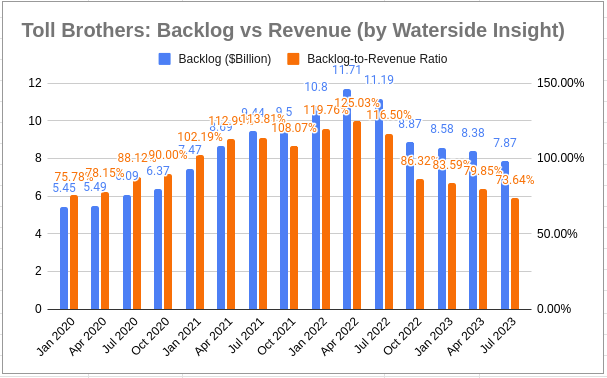
Toll Brothers has continued to push into the urban apartment market to explore more potential growth engines. The company formed “Toll Brothers City Living” unit to leverage its luxury brand in urban areas. Its pipeline includes most of the major cities on the east coast, south and west, except mid-west cities. It had spent in Q3 $263.5 million in purchasing contracts to acquire land for apartment development.
Toll Brothers: Apartment Living Pipeline (Company Presentation)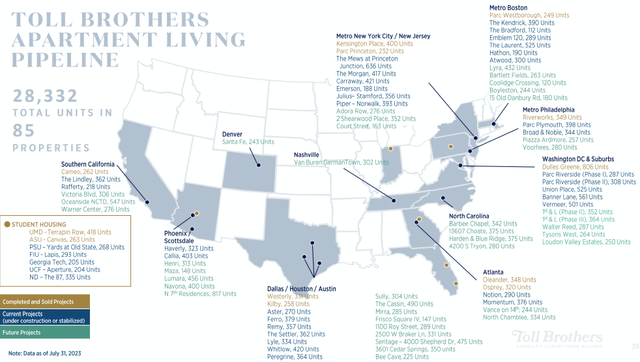
Since the company’s “affordable luxury” market focuses on millennials or empty nesters, it is not surprising the apartment market is the logical choice due to its community formation appeal to the younger professional that in turn provides higher sales volume for the investment, and its cost-saving of using steel framing in the building process. These factors underpin the “affordability” that it is trying to achieve.
Toll Brothers: Increasing Focus on Affordable Luxury (Company Presentation)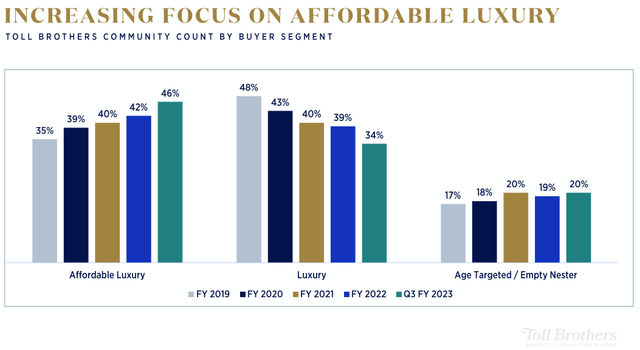
However, the sales of the apartment building assets are not as good as expected, which has impacted the full-year joint venture land sales and other income to be $105 million, down from the $125 million expected at the start of the year. This guidance is still hinged on the sale of three stabilized apartment communities that are to be closed in Q4. Its ancillary business, which includes apartment and city living, has reported losses for the three and nine months ending on July 31 with higher expenses than revenue.
Toll Brothers: Ancillary Business Revenue vs Expenses (Company 10Q by July 2023)
Toll Brothers’ cash conversion cycle is at around 438 days, which is mostly due to its faster inventory turnaround. But it is almost as good as it gets. There is very little room to improve compared with its best records in the past twenty years, while it could become prolonged to 700-800 days, the average of the past twenty years or so.
Toll Brothers:Cash Conversion Cycle (Calculated and Charted by Waterside Insight with data from company)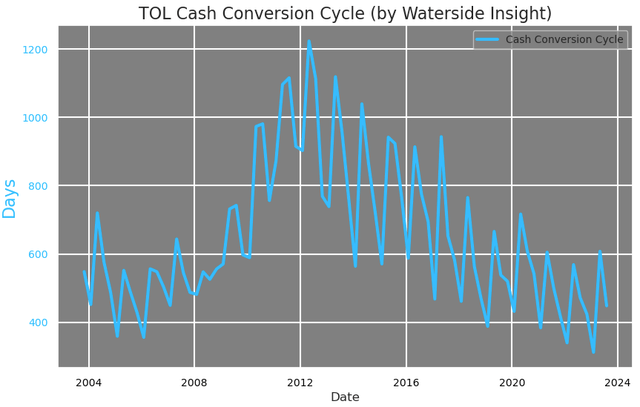
To update the previous mortgage loan held for sale data, it has fallen from $193 million to $83 million, the majority of which are residential mortgage loans. On one hand, this poses fewer risks to its portfolio that is subject to higher interest rate risks, on the other hand, with its home sales rising by 18.5% YoY in the quarter ending in July, there were 50% fewer mortgage loans held for sale on its book. This is due to 18.2% fewer mortgage loans originating in the first nine months of this year, and also reflects the tougher environment brought by the higher interest rate risks for the residential market. Either the company intentionally tightened the lending standard for cautious reasons or there were less qualified borrowers. Either way, it leads to fewer sales down the road, which brings us to the macro picture.
Toll Brothers: Mortgage Loans (Company 10Q by July 2023)
The Macro Picture
Toll Brothers’ latest presentation has a slide that compares the housing starts with the number of households, concluding the industry is undersupplied. We think this is not an accurate depiction of the situation. The number of households will always increase monotonically, in the long term. Yet housing starts can be best utilized to satisfy the incremental demands, not the entire stock of households.
Toll Brothers: Housing Industry is Undersupplied (Company Presentation)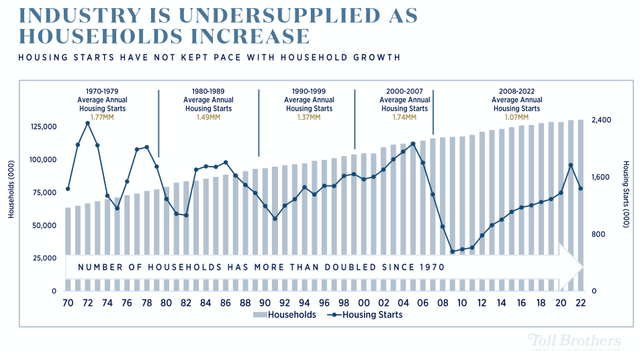
Therefore, we fixed up the following chart to see if we can show a picture more closely resembling the dynamics. We charted a 12-month average of monthly household formation, which is defined as the incremental change of the number of households on a monthly basis, against the monthly private-owned housing starts, from 1959 till June of this year. What we found is the average of household formation for the past 12 months although strong, when paired up with the current level of housing starts, it is right in the middle of the cluster. It is neither too high nor too low. Especially with the latest number reported in June falling slightly in the negatives, there is no significant undersupply for the industry from a high-level perspective. With that said, it is not excluding local regions heating up from supply and demand dynamics, but overall, the frenzy we saw in the past two years will not return any time soon.
Toll Brothers: Housing Starts vs Household Formation (Calculated and Charted by Waterside Insight with data from company)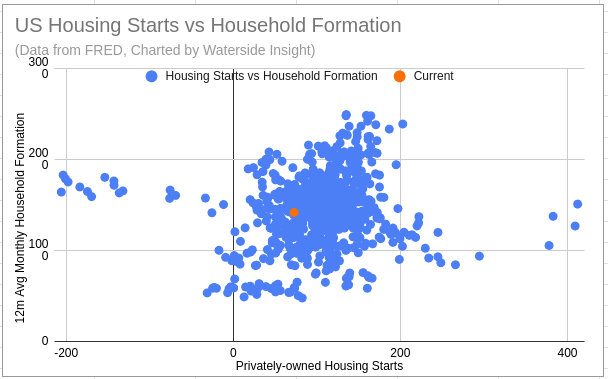
On the other hand, the current free cash flow Toll Brothers produce is an outlier, compared with its historical norm. What it means is it cannot sustain at these levels without regressing back to the average.
Toll Brothers: Free Cash Flow vs Housing Index (Calculated and Charted by Waterside Insight with data from company)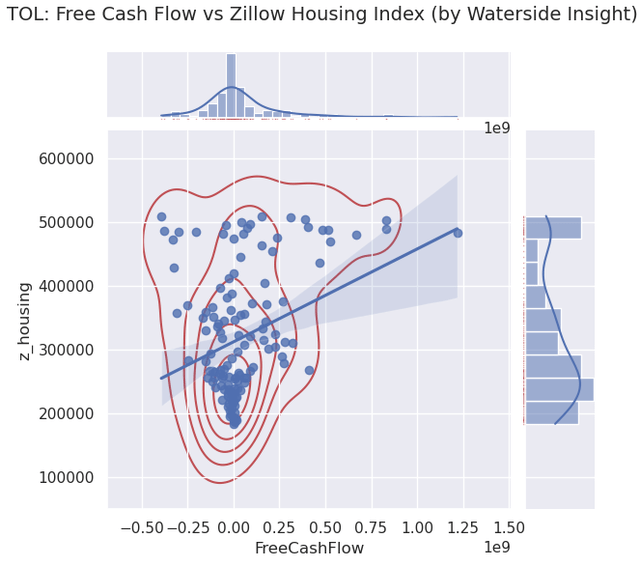
The current level of the owner’s equivalent rent for a primary residence is unsustainable given the interest rate environment. With 5.33% Fed Fund’s rate, the current rent level is almost double where it has been historically. For the inflation situation to fully come under control from the Fed’s point of view, rent being one of the largest items in the CPI basket, it will budge soon. Even if it doesn’t fall back down by half, a moderation or decline should be expected. This goes back to Toll Brothers’ efforts in expanding in the city and apartment living. The margin growth in that market may not be taking off in the near term.
US: Owner’s Equivalent Rent for Primary Residence vs Fed Fund’s Rate (Calculated and Charted by Waterside Insight with data from company)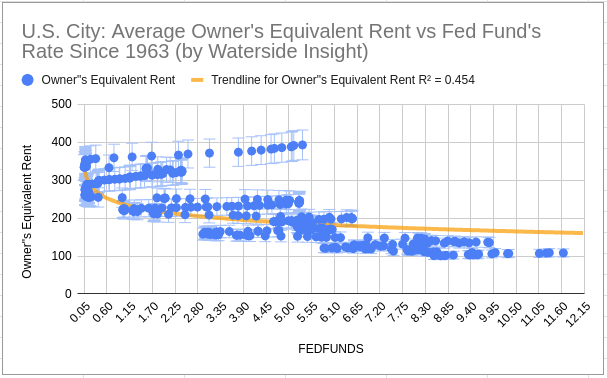
Lastly, although this doesn’t necessarily provide causation for stock valuation, it’s nonetheless observed that the high stock price has led to the most expensive and slowest stock repurchase for the company since 2016. With almost half of what it spent in 2022, $240 million stock repurchase has only bought back 3.5 million shares so far this year, roughly one-third of the number of shares it bought back last year.
Toll Brothers: Stock Repurchase History Since 2016 (Company Presentation)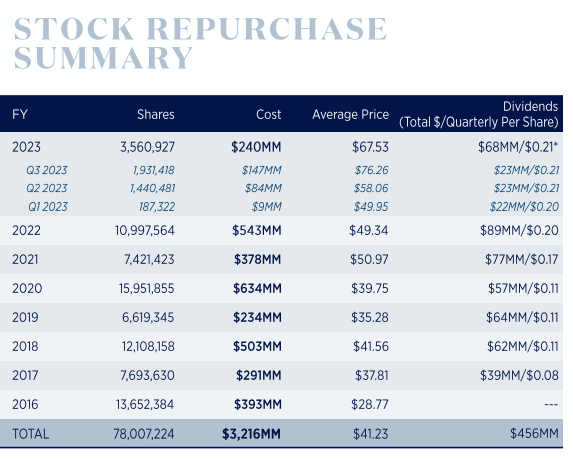
Financial Overview
Toll Brothers: Financial Overview (Calculated and Charted by Waterside Insight with data from company)
Valuation
We are sticking to our previous valuation and anticipate the slowdown we expected in January to come into play in Q4 or Q1 next year. The current price has risen above our bullish case by almost 14%.
Toll Brothers: Fair Valuation (Calculated and Charted by Waterside Insight with data from company)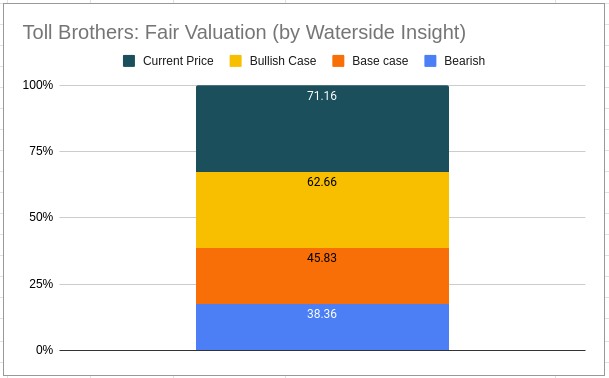
Conclusion
Toll Brothers has made higher sales this year against a tougher interest rate environment, which resulted in better cash flow and earnings so far. But we think this is mostly due to the influence of a previously higher backlog, which has fallen by more than 10% in the latest quarter. The effect of slowing down will start showing in Q4 latest Q1 next year and the macro pressure is pointing to a normalization that is merely being delayed not escaped. With its price rising above our bullish case, we think its stock is overvalued at the moment and recommend a sell.
Read the full article here



